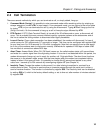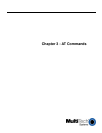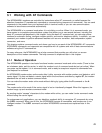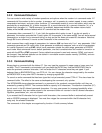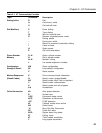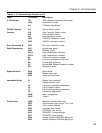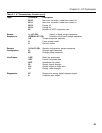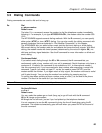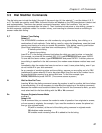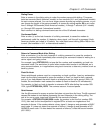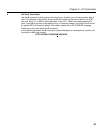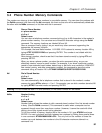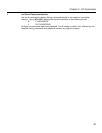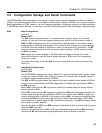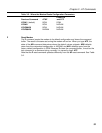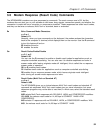
27
Chapter 3 - AT Commands
3.3 Dial Modifier Commands
The dial string can include the digits 0 through 9, the pound sign (#), the asterisk (*), and the letters A, B, C,
or D. The latter are used by some PBXs; the exact function will depend on the PBX manufacturer’s feature set
and implementation. There are also several command characters, called “dial modifiers,” that can be
included within a dialing command after the letter D. Their functions include pulse or tone dialing, pauses in
the dial sequence, automatic redials if a number is busy, and reverting to command mode or switching to
answer mode after dialing.
P, T Pulse or Tone Dialing
Default: P
The MT2834MR6’s modems can dial numbers by using pulse dialing, tone dialing, or a
combination of both methods. Pulse dialing, used by rotary-dial telephones, uses the timed
opening and closing of a relay to encode the numbers. Tone dialing, used by push-button
(touch-tone) telephones, uses dual tone multifrequency (DTMF) dialing.
P selects pulse dialing.
T selects tone dialing.
Insert P or T in the dialing command just before the digits you want to pulse- or tone-dial.
For example, to pulse-dial the number 555-1212, type ATDP5551212 and press ENTER.
To tone-dial the same number, type ATDT5551212 and press ENTER. If neither pulse nor
tone dialing is specified in the dial command, the modem uses whatever method was used
last.
Immediately after the modem has been turned on or reset, it uses pulse dialing, even if you
do not include P in your dial command.
As an example of combining pulse and tone dialing, assume you are calling out of a PBX
(switchboard) system where a 9 has to be pulse-dialed, then the rest of the number has to
be tone-dialed after pausing for a second dial tone. To dial this example, type
ATDP9,T5551212 and press ENTER. (The comma causes a pause.)
W Wait for New Dial Tone
Inserting W into the dialing command causes the modem to wait for another dial tone before
it resumes dialing. (It is not necessary to enter W at the beginning of the dialing command.)
Because the modem must be able to detect the dial tone for this command to work, you also
must select wait-for-dial-tone dialing with the X2 or X4 command.
Rn Reverse Originate/Answer Mode
n = 0 or 1
Default: R0
The R command lets you reverse the modem’s mode of operation from originate to answer,
or from answer to originate; for example, if you need the modem to answer the phone but
then go into originate mode.
R (with no number) at the end of the dialing string reverses in originate mode.
R0 disables mode reversing.
R1 enables mode reversing when R is added to the dial string.



